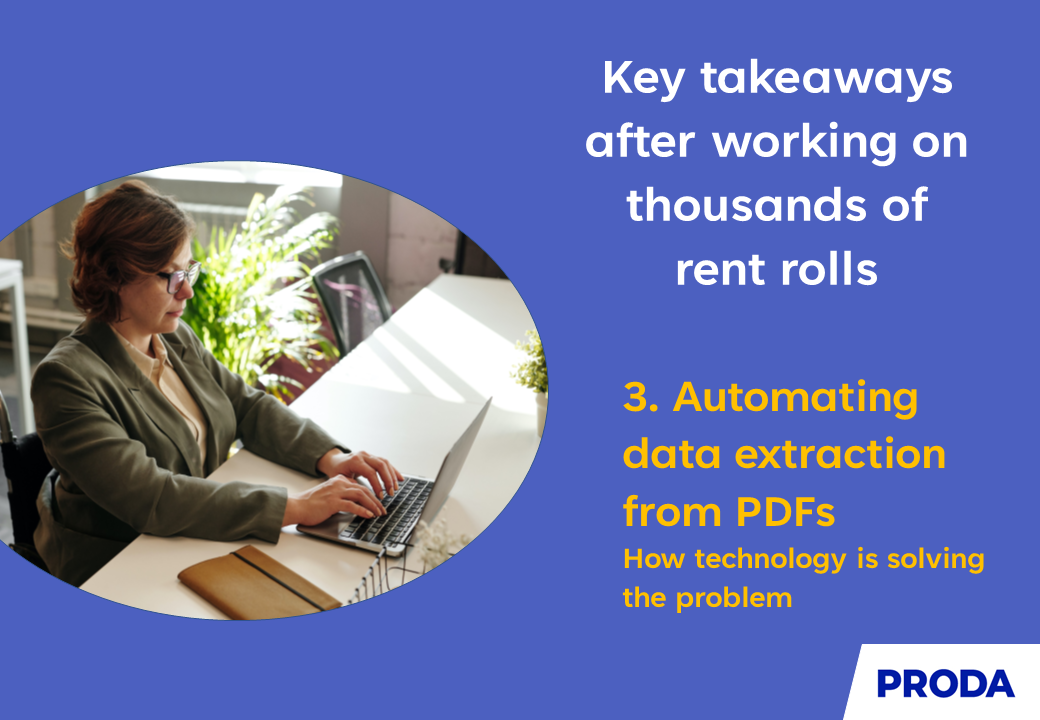Exploring what currently prevents productivity gains from data in the Commercial Real Estate industry
Following the launch of PRODA’s second blog series focused around data, this week we are back with the second post in the series, written by Matthew Eric Bassett – former CTO of PRODA. The post by Matthew explores what currently prevents productivity gains from data in the Commercial Real Estate industry and outlines what can be done to realise these productivity gains sooner, rather than later.
The core business processes of commercial real estate have not seen the same productivity gains from investments in data as other sectors. This is not because data is not relevant to the industry, but because such productivity gains require leaders to re-think those business processes and replace them with new ones. Such changes are impeded by a plethora of formats and standards used by different partners and IT suppliers throughout the industry, meaning that it would take a significant capital investment to implement them. Bespoke AI tools tailored to specific problems within commercial real estate could side-step these impediments, allowing commercial real estate professionals to realise time-saving productivity gains in fundamental business processes.
One of the most common business quotes of the last decade was “data is the new oil.” The analogy goes that data must be extracted and refined into actionable insight, as it is only in that processed form that it can fuel most of the 21st-century economy. This analogy is misguided. There are a handful of companies with access to petabytes of data from millions of consumers, and this data must indeed be refined into information to drive their product and marketing strategies. However, for most companies in commercial real estate, their business process revolves around relationships with dozens of suppliers and partners. They don’t see millions of transactions (or “interactions”) per second as, for example, Google does, but perhaps only a few hundred per year. These transactions do not require advanced deep learning algorithms to “refine” past data, but they do require a critical analysis of dozens of other documents.
“For these companies, data is not “the new oil.” It is more like electricity – something that flows through and powers a host of critical business processes and allows professionals to work more effectively. This analogy is instructive because of its historical examples.”
Experienced professionals need to read marketing brochures, white papers, rent rolls, and other documents. They then translate the data contained therein so that underwriting models, cash flow models, and investor reports can use it. The industry relies on professionals doing this sort of cognitive labour in a timely fashion to stay competitive in the same way technology companies rely on their large datasets about user behavior. This is why a 2015 report from McKinsey says that while technology companies like Amazon and Google have multiple examples of positive ROI from data, most companies have only a handful of successes[1]. For these companies, data is not “the new oil.” It is more like electricity – something that flows through and powers a host of critical business processes and allows professionals to work more effectively. This analogy is instructive because of its historical examples.
When electricity was first introduced to US factories, it took 40 to 50 years before the economic benefits were realised[2]. Factory processes were set up for steam power, managers and planners organised them around a large, central source of mechanical energy. Tools would need to be connected to a central belt driven by a steam engine. Electricity meant each tool or piece of equipment could have its own electric motor for an independent and versatile source of mechanical power.
However, to take advantage of electricity, factories needed to be re-organised, which required considerable capital investment. In addition to this, since electricity was so new, it was not yet clear what the most optimal organisation was. Companies needed to experiment, and experimentation with large capital investments does not make for a comfortable business plan. So, the productivity and business benefits of electricity didn’t arrive until decades after electricity reached factories.
We see the same thing with technology in today’s businesses. Telecommunications have allowed teams to collaborate and work effectively together from different physical locations. Nevertheless, few companies were willing to invest in the experimentation required to make it work until the global pandemic became an insurmountable risk to capital investments. It is also easy to imagine how new, emerging technologies like augmented reality, drones, and IoT could take decades to make an impact in commercial real estate operations. But, we can also see it in the business processes that make up commercial real estate today, even after data and computers have been around for decades.
The processes involved in evaluating a deal or managing a property were designed around a central group of experts having the knowledge and expertise to perform a specific form of cognitive labour: the translation of data from marketing brochures, white papers, rent rolls, etc. into the inputs required for underwriting models, cash flow models, investor reports, and other documents. To implement a time-saving, data-driven workflow all these documents need to be machine-readable so that a computer could perform that same cognitive labour, allowing professionals to think about higher-level business priorities. Yet, these documents are produced by dozens of suppliers and partners. Property management software, operating partners, agents, etc. all need to agree on a specification for all documents exchanged – the exact sort of capital investment that would delay the industry from taking advantage of new workflows.
“Pundits sometimes portray AI as a replacement for humans, but it is better thought of as a tool for cognitive labour. Much like a drill or a jackhammer empowers a construction worker, AI could allow professionals to work more effectively by free-ing them from the sort of time-consuming, monotonous work that an inexperienced outsider would struggle to do. “
Enter AI
So, what can today’s managers do to realise these productivity gains sooner? At the core, it is the lack of machine-readable formats for rent rolls, marketing materials, and other documents that impede the implementation of data-driven business processes. But Artificial Intelligence turns this into a technology problem.
Artificial Intelligence, much like data itself, has also delivered fewer benefits to business than it has promised, but for entirely different reasons. Pundits sometimes portray AI as a replacement for humans, but it is better thought of as a tool for cognitive labour. Much like a drill or a jackhammer empowers a construction worker, AI could allow professionals to work more effectively by free-ing them from the sort of time-consuming, monotonous work that an inexperienced outsider would struggle to do. AI researchers, however, are generally unaware of the specific problems and pain points in today’s business problems as they work in different fields and lack visibility to industry; and some managers often invest in top-down AI programs rather than optimising or improving specific business processes[3].
Yet when researchers are informed about specific business problems, they can create solutions that automate the sort of cognitive labour required to translate an agency market report and a rent roll into an underwriting model. In particular, AI can perform the work of extracting information from documents and converting between formats and standards just when it is needed so that there is never a need to get suppliers and partners to converge on machine-readable formats. Therefore, it allows managers to experiment with and deploy new business processes today with little cost. PRODA’s team of software engineers and researchers have been developing exactly such a tool for commercial real estate.
So we see that AI – when properly deployed – can help businesses realise today, the productivity gains of their existing IT infrastructure, rather than wait years (or for another economic crisis) to justify the capital investment required to change critical processes.
[1 ] See Getting big impact from big data , Jan 2015, [2] See Capitalism without Capital, Haskel and Westlake. Also “The Dynamo and the Computer: An Historical Perspective on the Modern Productivity Paradox” Paul David (1990), [3] See “Why is Artificial Intelligence So Useless for Business?” or “An Algorithm for B2B Products“.
– Written by Matthew Eric Bassett
A huge thank you to Matthew for writing the latest post in our data blog series. We will be back next week with another post in our data blog series. If you would like to be updated on new posts in the series, you can sign up to our newsletter, below. If you are interested in featuring in any of our blog series, please email mveja@proda.ai.
For the latest news and updates follow us on Twitter and Linked In




